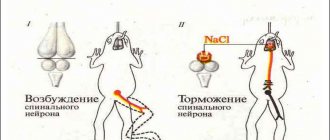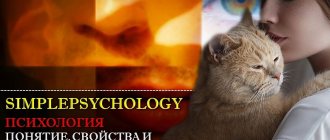Higher nervous activity is a system that allows the human and animal body to adapt to variable environmental conditions. Evolutionarily, vertebrates have developed a number of innate reflexes, but their existence is not enough for successful development.
In the process of individual development, new adaptive reactions are formed - these are conditioned reflexes. Outstanding domestic scientist I.P. Pavlov is the founder of the doctrine of unconditioned and conditioned reflexes. He formed the conditioned reflex theory, which states that the acquisition of a conditioned reflex is possible through the action of a physiologically indifferent irritation on the body. As a result, a more complex system of reflex activity is formed.
I.P. Pavlov - the founder of the doctrine of unconditioned and conditioned reflexes
An example of this is Pavlov's study of dogs that salivated in response to a sound stimulus. Pavlov also showed that innate reflexes are formed at the level of subcortical structures, and new connections are formed in the cerebral cortex throughout the life of an individual under the influence of constant irritations.
Classification of reflexes
In modern science, such reactions are described using several classifications that describe their features in different ways.
So, they come in the following types:
- Conditional and unconditional - depending on how they are formed.
- Exteroceptive (from “extra” - external) - reactions of external receptors of the skin, hearing, smell and vision. Interoreceptive (from “intero” inside) – reactions of internal organs and systems. Proprioceptive (from “proprio” - special) - reactions associated with the sensation of one’s own body in space and formed by the interaction of muscles, tendons and joints. This is a classification based on receptor type.
- Based on the type of effectors (zones of reflex response to information collected by receptors), they are divided into: motor and autonomic.
- Classification based on specific biological role. There are species aimed at protection, nutrition, orientation in the environment and reproduction.
- Monosynaptic and polysynaptic - depending on the complexity of the neural structure.
- Based on the type of influence, excitatory and inhibitory reflexes are distinguished.
- And based on where the reflex arcs are located, they are divided into cerebral (various parts of the brain are included) and spinal (neurons of the spinal cord are included).
Braking
External unconditional inhibition (innate) is carried out by the action of a very strong stimulus on the body. The termination of the conditioned reflex occurs due to the activation of nerve centers under the influence of a new stimulus (this is transcendental inhibition).
When the organism under study is exposed to several stimuli at the same time (light, sound, smell), the conditioned reflex fades, but over time the indicative reflex is activated and the inhibition disappears. This type of braking is called temporary.
Conditioned inhibition (acquired) does not arise on its own; it must be developed. There are 4 types of conditioned inhibition:
- Extinction (disappearance of a persistent conditioned reflex without constant reinforcement by the unconditioned);
- differentiation;
- conditional brake;
- delayed braking.
Inhibition is a necessary process in our life. In its absence, many unnecessary reactions would occur in the body that would not be beneficial.
Example of external inhibition (dog's reaction to a cat and the SIT command)
The difference between unconditioned reflexes and conditioned ones
They differ in that unconditional ones are innate. They are the same for all animals of one species or another, as they are inherited. They are quite unchanged throughout the life of a person or animal. From birth and always occur in response to receptor irritation, and are not produced.
Conditional ones are acquired throughout life, with experience in interaction with the environment. Therefore, they are quite individual - depending on the conditions under which it was formed. They are unstable throughout life and can fade away if they do not receive reinforcement.
Higher nervous activity
Higher nervous activity (HNA), carried out by the cerebral cortex, ensures the most perfect adaptation of humans and animals to constantly changing environmental conditions and underlies higher mental functions of humans, such as thinking, memory, consciousness and learning.
“Father of Russian physiology” - I.M. Sechenov wrote the book “Reflexes of the Brain,” where he put forward a theory about the reflex principle that underlies the activity of the internal nervous system. These ideas were continued and developed by I.P. Pavlov, who experimentally proved that conditioned reflexes underlie GNI.
While studying the digestive system, you learned about the experience of I.P. Pavlov, with the help of which he studied the mechanism of salivation. After conducting experiments, Pavlov discovered that some of the reflexes are innate - permanent, and the other - acquired.
With numerous coincidences of the conditioned (signal) and the unconditioned stimulus reinforced by it, a conditioned reflex is formed. That is, a conditioned reflex always arises on the basis of an unconditioned reflex with repeated coincidence of the above stimuli.
Conditioned and unconditioned reflexes
Now let’s look in more detail at the differences between conditioned reflexes and unconditioned ones:
- Acquired - congenital
- Individual - group
- Nonspecific - specific
- Changeable - constant
- With bark - without bark
Conditioned reflexes are acquired: they are absent in a newborn and can arise and fade throughout life. Unconditioned reflexes are innate, genetically determined and inherited.
Conditioned reflexes are individual, determined by previous experience: a child who sees a lemon for the first time in his life does not salivate, but after eating it, even the thought of a lemon can cause profuse salivation. Unconditioned reflexes are characteristic of all individuals of the species without exception.
Conditioned reflexes arise in response to a nonspecific stimulus, for example, light, if the dog has a conditioned reflex to light. Unconditioned reflexes arise in response to a specific stimulus: sound is perceived by the receptors of the inner ear, light - by the rods and cones of the retina.
Conditioned reflexes are acquired as an adaptation to specific environmental conditions; when the environment changes, they also change and can be lost and reappear. Unconditioned reflexes are constant, given from birth and do not fade throughout life.
Conditioned reflexes always arise and are carried out with the participation of the cerebral cortex; unconditioned reflexes can do without its participation. The main thing is to remember and realize that any conditioned reflex is carried out on the basis of an unconditioned reflex.
The mechanism of conditioned reflex formation
The study of conditioned reflexes is closely connected with Pavlov and his students. Now we will conduct an experiment on a dog.
Let's assume that we need to develop a salivation reflex in an animal in response to turning on the light. We will use food as an unconditional stimulus, and turning on a light bulb as a conditioned stimulus.
A few seconds before we give food to the dog, we need to turn on the light bulb. If we repeat this manipulation several times, the dog will develop a conditioned reflex to turn on the light bulb, and in the future, salivation will begin at the moment the light turns on.
This effect is due to the fact that in the dog’s brain a temporary connection arises between the visual center (in the occipital lobe of the CBP) and the food center. As our manipulation is repeated, this temporary connection becomes stronger - a closure occurs and a conditioned reflex is formed.
Inhibition of reflexes
Inhibition processes are obligatory concomitants of excitation processes in the nervous system. Sechenov was the first to discover and describe the process of inhibition, proving that irritation of the nerve centers of the diencephalon inhibits the reflex activity of the spinal cord.
Pavlov developed the teachings of Sechenov and also studied the processes of inhibition. He came to the conclusion that in the nervous system the processes of excitation and inhibition are interconnected and occur continuously. Moreover, thanks to inhibition, the conditioned reflex is of the most accurate and perfect adaptive nature in relation to the environment.
Pavlov described two types of cortical inhibition:
- Unconditional (external)
- Conditional (internal)
Unconditional (external) inhibition is associated with the emergence in the cerebral cortex of a new (external) focus of excitation caused by the action of some external stimulus (sharp sound, loud noise). The action of this stimulus causes a weakening or complete disappearance of the current conditioned reflex.
This is an innate inhibition; it does not require development, which is why Pavlov called it unconditional (external).
Conditioned (internal) inhibition occurs in the same area of the cortex where the center of the conditioned reflex is located. Conditioned inhibition develops gradually. Remember how we developed a conditioned reflex in a dog to turn on a light bulb. If we stop giving food and continue to turn on the light bulb, then gradually the dog’s salivation will fade away - this is conditioned inhibition.
In order for the conditioned reflex to be maintained, it is necessary to reinforce it as often as possible: in our case, light (the conditioned stimulus) is reinforced with food (the unconditioned stimulus). If you stop turning on the light bulb before giving the dog food, the conditioned reflex will gradually weaken and disappear. This process is called extinction - the disappearance of a conditioned reflex, but if desired, it can be created again.
Pavlov's doctrine of the first and second signal systems
Animals have only the first signaling system. Pavlov considered it as a set of nervous structures with the help of which the perception of the surrounding world occurs through the senses. The signals in the first signaling system are smell, color, sound - they cause unconditioned reflexes and serve as the basis for the formation of conditioned reflexes.
Pavlov also proved that animals do not have a second signaling system. His experiment consisted of placing a monkey on a raft in the middle of a lake. The monkey could use a pole to climb onto two other rafts. On one of them there was a bailer and a tank of water, on the other raft a fire started. The monkey put out the fire by performing complex actions: each time he climbed onto a raft with a water tank and scooped water from there, instead of scooping water from a lake, which was much closer. Consequently, animals are not capable of generalization and abstract thinking.
In the process of work and communication, a person developed a second signaling system, closely related to the emergence of speech. Here, the specific irritant is the words into which a person puts meaning, some concept.
Words have a generalizing meaning, which served as the basis for the possibility of generalization, abstraction and operating with concepts. Language puts the results of human activity into words, so you can imagine a monkey even if you don't see it. Thanks to oral and especially written speech, it becomes possible to transfer experience to future generations. For any book, including this textbook, it is also worth saying special thanks to the second signaling system.
Temperament types
Pavlov identified four types of temperament, depending on the strength, balance and mobility of nervous processes in the cerebral cortex. Choleric is an easily excitable type, sanguine is balanced. Phlegmatic - processes of excitation and inhibition of weak strength, persistent and diligent in work. And finally, a melancholic person - the processes of excitation and inhibition are unbalanced and weak - are very vulnerable and weak-willed, prone to deep experiences.
Emotions, thinking and memory
Emotions are a person’s subjective reactions to external and internal stimuli. Emotions can be positive and negative; they reflect subjective experiences about the objective surrounding reality.
Thinking is a set of mental processes aimed at understanding the surrounding reality and thanks to which a person understands the essence of phenomena and things - as a result of thinking, concepts are formed. A distinction is made between elementary thinking, which is inherent in all animals (the first signaling system), and abstract thinking, which is characteristic only of humans (the second signaling system).
Memory is the ability of the nervous system (brain), which consists in the possibility of consolidating, storing and further reproducing received information. Based on the storage time of information, memory is divided into short-term and long-term.
Any information we receive first goes into short-term memory, only with repeated reproduction does this information move into long-term memory. The following types of memory are distinguished: visual, auditory, motor, tactile, mixed.
Dream
Sleep is a state of depression of consciousness, during which all types of sensitivity are reduced. Normally, the duration of sleep in an adult is 7-8 hours; in newborns, the duration of sleep reaches 18-20 hours a day. During sleep, information received during the day is transferred to long-term memory. Without sleep for more than 1-2 weeks, death is possible.
There are two phases of sleep: slow and fast, which alternate several times in one night. The slow-wave sleep phase consists of physiological rest of all body systems: heart rate, blood pressure, and body temperature decrease. Hormones begin to be released more actively, the action of which is associated with tissue restoration.
The REM sleep phase is the phase in which we dream. In this interval, the eyeballs actively move, breathing may become more frequent, and the hands make movements. This phase occurs approximately every 60-80 minutes (after the slow-wave sleep phase). Thus, in one night we see many dreams, most of which we forget. By the way, various “smart” alarm clocks catch exactly the moment of the REM sleep phase, in which it is easiest to wake a person, and upon awakening, the dream is usually remembered.
A dream is a unique representation of received information in the form of visual images. Let me note an interesting fact: we have already seen all the people we see in our dreams in reality. It could have been the face of a random passerby we met several years ago: such information is hidden deep in the subconscious.
Many of us, including me, have experienced a state of altered consciousness - a lucid dream. This is surprising, but sometimes during sleep a person can realize that he is dreaming, his dream is unreal, and it can be changed as soon as he pleases. After such moments, you experience extreme euphoria, dreams with your own scenario are remembered for a long time.
Diseases
Somnambulism (obsolete - sleepwalking) is a painful condition in which people perform any actions while in a state of sleep. Most often, sleepwalking occurs during a period of incomplete awakening after a deep sleep phase. An attack of sleepwalking can last up to several hours; sleepwalking most often occurs in children.
This condition has been known since ancient times, but its causes still remain a mystery. There is also no information whether sudden awakening harms a sleepwalker in a state of sleepwalking or not. Most often, sleepwalkers perform stereotypical actions: getting up, cleaning, walking, after which they go to bed and the next morning they do not remember anything about what happened.
Sometimes the actions of sleepwalkers pose a danger to themselves and others. There are cases when sleepwalkers traveled hundreds (!) kilometers from their home, and after waking up they found themselves in another part of the country completely disoriented.
© Bellevich Yuri Sergeevich 2018-2021
This article was written by Yuri Sergeevich Bellevich and is his intellectual property. Copying, distribution (including by copying to other sites and resources on the Internet) or any other use of information and objects without the prior consent of the copyright holder is punishable by law. To obtain article materials and permission to use them, please contact Yuri Bellevich
.
Conditioned and unconditioned reflexes comparison table
| Unconditional | Conditional |
| Congenital | Formed throughout life |
| Constant, unchanging | They change. Until complete extinction |
| Uniform in all animals of the species | Have high individual variability |
| Helps adapt to stable environmental conditions | Helps adapt to changing environmental conditions |
| The central part of the reflex arc passes through the spinal cord and brain | The central part of the reflex arc passes through the cerebral cortex |
Needs and behaviors
Congenital species:
- Unconditioned reflexes. Instincts:
- Vital: food, regulation of forces, etc.
- Role-playing, zoosocial: gender, parental, child, territorial.
- Self-development, ideal: freedom and overcoming, play, research, imitation.
- Approximate.
- Imprinting.
Purchased, individual:
- Conditioned reflexes.
- Alternation of sleep and wakefulness.
- Behavior formed through learning:
- Voluntary memory and attention.
- Walking, speech, household, sports, professional skills.
Exploratory behavior –> formation of a spatio-temporal image of the surrounding world.
- Orienting reflex.
- Need for information –> exploratory behavior: formation of an image of the surrounding world.
The difference between instincts and unconditioned reflexes
Instinct, like reflex, is a biologically significant form of animal behavior. Only the second is a simple short response to a stimulus, and instinct is a more complex activity that has a specific biological goal.
The unconditioned reflex is always triggered. But instinct is only in a state of biological readiness of the body to trigger this or that behavior. For example, mating behavior in birds is triggered only during a certain period of the year when chick survival may be maximum.
What is not typical for unconditioned reflexes?
In short, they cannot change during life. They do not differ between different animals of the same species. They cannot disappear or stop appearing in response to a stimulus.
Meaning in life
To survive and preserve one’s own species, reflexive unconditional activity is necessary. A good example of this is childbirth. The baby faces many unforeseen dangers in the new world. Conditioned reflexes will help you adapt to the environment. Thanks to them, the individual quickly adapts.
Animals can be located in a safer place and escape. And they do not allow a person to make a mistake when choosing food (spoiled, poisonous, etc.). When you see appetizing dishes, gastric juice is formed and produced in order to better digest food.
Imprint
This form of unconditioned reflex is also called imprinting. There are periods in the life of every individual when the entire surrounding environment is imprinted on the brain. For each species, this time period may be different: for some it lasts several hours, and for others it lasts several years.
Remember how easily young children master foreign speech skills. While schoolchildren put a lot of effort into this.
It is thanks to imprinting that all babies recognize their parents and distinguish individuals of their species. For example, after the birth of a baby, a zebra spends several hours alone with it in a secluded place. This is exactly the time that is necessary for the cub to learn to recognize its mother and not confuse her with other females in the herd.
This phenomenon was discovered by Konrad Lorenz. He conducted an experiment with newborn ducklings. Immediately after the hatching of the latter, he presented them with various objects, which they followed like a mother. They even perceived him as a mother, and followed him around.
Everyone knows the example of hatchery chickens. Compared to their relatives, they are practically tame and are not afraid of humans, because from birth they see him in front of them.
Creators of the science of reflexes
The term and the very concept of a biological reflex were introduced into science by the French philosopher, physicist and mathematician Rene Descartes (1596-1650). He described the external manifestations quite accurately, but his understanding of the physiology of these processes was far from the truth. Therefore, he is usually not included in the list of scientists who created the doctrine of reflexes.
The creator of this theory is considered to be the Russian scientist Ivan Sechenov (1829-1905). His ideas were developed and supported by real experiments by Vladimir Bekhterev (1857-1927) and Ivan Pavlov (1849-1936). Despite the fact that Bekhterev is mentioned less often in this context than Pavlov, his contribution is also enormous. It was he who created reflexology (a branch of psychology in which all higher nervous activity is considered as a set of reflexes).
Pavlov is known for his practical experiments, as well as for dividing conditioned and unconditioned reflexes. He conducted a huge number of experiments on animals, studying their reactions to various stimuli. At the same time, the most famous was, of course, the experiment with a bell that caused the dog to secrete saliva and gastric juice. Having conducted experiments on different animals, Pavlov became convinced that conditioned reflexes are always formed if the stimulus for the animal is sufficiently unambiguous.
Behavioral reactions
This type of unconditioned reflex can be well demonstrated in animals. Behavioral reactions include:
- The dog's desire to carry and pick up objects. Retrieval reaction.
- Showing aggression at the sight of a stranger. Active defensive reaction.
- Finding objects by smell. Olfactory-search reaction.
It is worth noting that a behavioral reaction does not mean that the animal will certainly behave this way. What is meant? For example, a dog that has a strong active-defensive reaction from birth, but is physically weak, most likely will not show such aggression.
These reflexes can determine the animal's actions, but they can be controlled. They should also be taken into account when training: if an animal completely lacks an olfactory-search reaction, then it is unlikely that it will be possible to train it as a search dog.
Reflex arc
It takes us about 500 milliseconds to respond to an event with a basic decision. If a decision does not need to be made, we can react in 100-200 milliseconds. At the same time, some reflexes work tens of times faster, and this is only possible due to the fact that thinking is not involved in this process.
A reflex is a reaction to an external influence that occurs without involving the cerebral cortex in this process (the nerve impulse passes through the spinal cord or stem). The path that the impulse travels is called a reflex arc. For example, if a person withdraws his hand from a burning object, the reflex arc includes the following elements:
- receptor (nerve endings in the finger that generate an impulse);
- afferent link (sensory neuron going to the spinal cord);
- the nerve center that determines the response (a small complex of neurons in the spinal cord);
- efferent link (motor neuron transmitting a signal to the muscle);
- effector (muscle that withdraws the hand).
The reflex arc provides an emergency response to a dangerous impact even before the person realizes that he has been burned. Because this reaction is not meaningful, in some cases it can lead to an undesirable result (for example, by withdrawing a hand, a person may push someone, lose balance, or get hurt).
What is the role of unconditioned reflexes in human life?
Human evolution over the centuries has been accompanied by changes in the genetic apparatus, the selection of traits that are necessary for survival in the surrounding nature. The nervous system became a highly organized matter. What is the significance of unconditioned reflexes - answers can be found in the works of physiologists Sechenov, I.P. Pavlova, P.V. Simonova. Scientists have identified several important functions:
- maintaining homeostasis (self-regulation of the internal environment) in optimal balance;
- adaptation and adaptation of the body (mechanisms of thermoregulation, respiration, digestion);
- preservation of species characteristics;
- reproduction.
Spinal motor automatisms
Many unconditioned reflexes belong to this group. Examples include the following:
- Moro reflex. When a reaction is caused, for example, by hitting the table near the baby's head, the latter's arms are spread to the sides. Appears up to 4-5 months.
- Automatic gait reflex. When supported and slightly tilted forward, the baby makes stepping movements. After 1.5 months it begins to fade.
- Galant reflex. If you run your finger along the paravertebral line from the shoulder to the buttocks, the body bends towards the stimulus.
Unconditioned reflexes are assessed on a scale: satisfactory, increased, decreased, absent.
Congenital reflexes of an infant
After birth, the baby goes through a complex developmental path that consists of several stages. The degree and speed of mastery of various skills will directly depend on the state of the nervous system. The main indicator of its maturity is the unconditioned reflexes of the newborn.
The presence of them in the baby is checked immediately after birth, and the doctor makes a conclusion about the degree of development of the nervous system.
From the huge number of hereditary reactions, the following can be distinguished:
- Kussmaul search reflex. When the area around the mouth is irritated, the child turns his head towards the irritant. The reflex usually fades by 3 months.
- Sucking. If you place your finger in the baby's mouth, he begins to perform sucking movements. Immediately after feeding, this reflex fades away and becomes more active after some time.
- Palmo-oral. If you press on the child's palm, he opens his mouth slightly.
- Grasping reflex. If you put your finger in the baby’s palm and lightly press it, a reflexive squeezing and holding occurs.
- The inferior grasp reflex is caused by light pressure on the front of the sole. The toes flex.
- Crawling reflex. When lying on the stomach, pressure on the soles of the feet causes a crawling movement forward.
- Protective. If you lay a newborn on his stomach, he tries to raise his head and turns it to the side.
- Support reflex. If you take the baby under the armpits and place him on something, he will reflexively straighten his legs and rest on his entire foot.
The unconditioned reflexes of a newborn can go on for a long time. Each of them symbolizes the degree of development of certain parts of the nervous system. After an examination by a neurologist in the maternity hospital, a preliminary diagnosis of some diseases can be made.
From the point of view of their significance for the baby, the mentioned reflexes can be divided into two groups:
- Segmental motor automatisms. They are provided by segments of the brain stem and spinal cord.
- Posotonic automatisms. Provide regulation of muscle tone. The centers are located in the midbrain and medulla oblongata.











